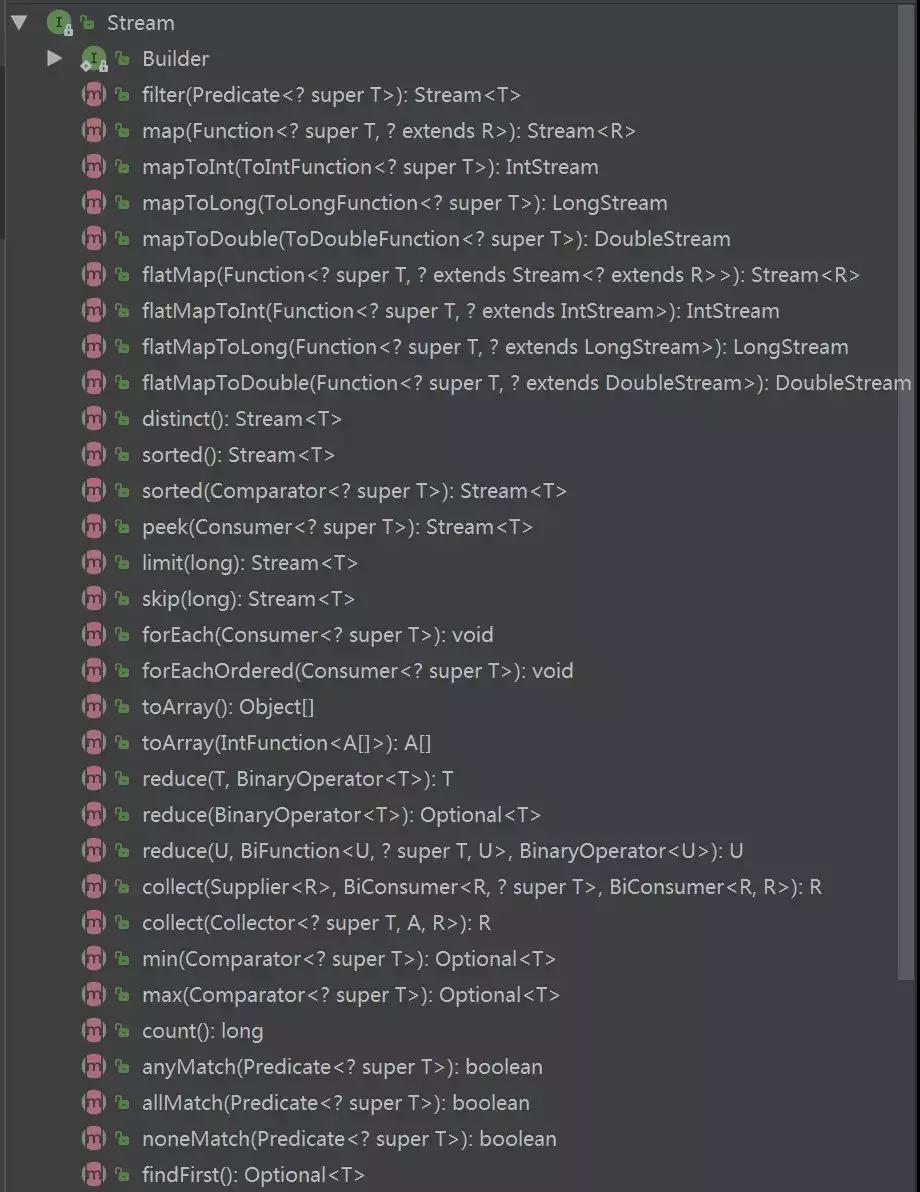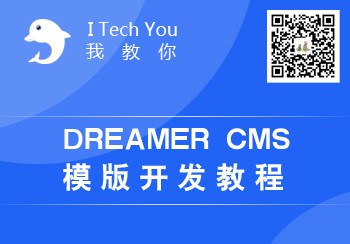简介
java8也出来好久了,接口默认方法,lambda表达式,函数式接口,Date API等特性还是有必要去了解一下。比如在项目中经常用到集合,遍历集合可以试下lambda表达式,经常还要对集合进行过滤和排序,Stream就派上用场了。用习惯了,不得不说真的很好用。
Stream作为java8的新特性,基于lambda表达式,是对集合对象功能的增强,它专注于对集合对象进行各种高效、便利的聚合操作或者大批量的数据操作,提高了编程效率和代码可读性。
Stream的原理:将要处理的元素看做一种流,流在管道中传输,并且可以在管道的节点上处理,包括过滤筛选、去重、排序、聚合等。元素流在管道中经过中间操作的处理,最后由最终操作得到前面处理的结果。
集合有两种方式生成流:
stream() − 为集合创建串行流
parallelStream() - 为集合创建并行流

上图中是Stream类的类结构图,里面包含了大部分的中间和终止操作。
中间操作主要有以下方法(此类型方法返回的都是Stream):map (mapToInt, flatMap 等)、 filter、 distinct、 sorted、 peek、 limit、 skip、 parallel、 sequential、 unordered
终止操作主要有以下方法:forEach、 forEachOrdered、 toArray、 reduce、 collect、 min、 max、 count、 anyMatch、 allMatch、 noneMatch、 findFirst、 findAny、 iterator
举例说明
首先为了说明Stream对对象集合的操作,新建一个Student类(学生类),覆写了equals()和hashCode()方法
1public class Student {
2 private Long id;
3 private String name;
4 private int age;
5 private String address;
6 public Student() {}
7
8 public Student(Long id, String name, int age, String address) {
9 this.id = id;
10 this.name = name;
11 this.age = age;
12 this.address = address;
13 }
14
15 @Override
16 public String toString() {
17 return "Student{" +
18 "id=" + id +
19 ", name='" + name + '\'' +
20 ", age=" + age +
21 ", address='" + address + '\'' +
22 '}';
23 }
24
25 @Override
26 public boolean equals(Object o) {
27 if (this == o) return true;
28 if (o == null || getClass() != o.getClass()) return false;
29 Student student = (Student) o;
30 return age == student.age &&
31 Objects.equals(id, student.id) &&
32 Objects.equals(name, student.name) &&
33 Objects.equals(address, student.address);
34 }
35
36 @Override
37 public int hashCode() {
38 return Objects.hash(id, name, age, address);
39 }
40
41 public Long getId() {
42 return id;
43 }
44
45 public void setId(Long id) {
46 this.id = id;
47 }
48
49 public String getName() {
50 return name;
51 }
52
53 public void setName(String name) {
54 this.name = name;
55 }
56
57 public int getAge() {
58 return age;
59 }
60
61 public void setAge(int age) {
62 this.age = age;
63 }
64
65 public String getAddress() {
66 return address;
67 }
68
69 public void setAddress(String address) {
70 this.address = address;
71 }
72
73}
filter(筛选)
1public static void main(String [] args) {
2 Student s1 = new Student(1L, "肖战", 15, "浙江");
3 Student s2 = new Student(2L, "王一博", 15, "湖北");
4 Student s3 = new Student(3L, "杨紫", 17, "北京");
5 Student s4 = new Student(4L, "李现", 17, "浙江");
6 List<Student> students = new ArrayList<>();
7 students.add(s1);
8 students.add(s2);
9 students.add(s3);
10 students.add(s4);
11
12 List<Student> streamStudents = testFilter(students);
13 streamStudents.forEach(System.out::println);
14}
15/**
16 * 集合的筛选
17 * @param students
18 * @return
19 */
20private static List<Student> testFilter(List<Student> students) {
21 //筛选年龄大于15岁的学生
22 //return students.stream().filter(s -> s.getAge()>15).collect(Collectors.toList());
23 //筛选住在浙江省的学生
24 return students.stream().filter(s ->"浙江".equals(s.getAddress())).collect(Collectors.toList());
25}
运行结果:

这里我们创建了四个学生,经过filter的筛选,筛选出地址是浙江的学生集合。
map(转换)
1public static void main(String [] args) {
2 Student s1 = new Student(1L, "肖战", 15, "浙江");
3 Student s2 = new Student(2L, "王一博", 15, "湖北");
4 Student s3 = new Student(3L, "杨紫", 17, "北京");
5 Student s4 = new Student(4L, "李现", 17, "浙江");
6 List<Student> students = new ArrayList<>();
7 students.add(s1);
8 students.add(s2);
9 students.add(s3);
10 students.add(s4);
11
12 testMap(students);
13}
14
15/**
16 * 集合转换
17 * @param students
18 * @return
19 */
20private static void testMap(List<Student> students) {
21 //在地址前面加上部分信息,只获取地址输出
22 List<String> addresses = students.stream().map(s ->"住址:"+s.getAddress()).collect(Collectors.toList());
23 addresses.forEach(a ->System.out.println(a));
24}
运行结果

map就是将对应的元素按照给定的方法进行转换。
distinct(去重)
1public static void main(String [] args) {
2 testDistinct1();
3}
4
5/**
6 * 集合去重(基本类型)
7 */
8private static void testDistinct1() {
9 //简单字符串的去重
10 List<String> list = Arrays.asList("111","222","333","111","222");
11 list.stream().distinct().forEach(System.out::println);
12}
运行结果:

1public static void main(String [] args) {
2 testDistinct2();
3}
4
5/**
6 * 集合去重(引用对象)
7 */
8private static void testDistinct2() {
9 //引用对象的去重,引用对象要实现hashCode和equal方法,否则去重无效
10 Student s1 = new Student(1L, "肖战", 15, "浙江");
11 Student s2 = new Student(2L, "王一博", 15, "湖北");
12 Student s3 = new Student(3L, "杨紫", 17, "北京");
13 Student s4 = new Student(4L, "李现", 17, "浙江");
14 Student s5 = new Student(1L, "肖战", 15, "浙江");
15 List<Student> students = new ArrayList<>();
16 students.add(s1);
17 students.add(s2);
18 students.add(s3);
19 students.add(s4);
20 students.add(s5);
21 students.stream().distinct().forEach(System.out::println);
22}
运行结果:

可以看出,两个重复的“肖战”同学进行了去重,这不仅因为使用了distinct()方法,而且因为Student对象重写了equals和hashCode()方法,否则去重是无效的。
sorted(排序)
1public static void main(String [] args) {
2 testSort1();
3}
4
5/**
6 * 集合排序(默认排序)
7 */
8private static void testSort1() {
9 List<String> list = Arrays.asList("333","222","111");
10 list.stream().sorted().forEach(System.out::println);
11}
运行结果:

1public static void main(String [] args) {
2 testSort2();
3}
4
5/**
6 * 集合排序(指定排序规则)
7 */
8private static void testSort2() {
9 Student s1 = new Student(1L, "肖战", 15, "浙江");
10 Student s2 = new Student(2L, "王一博", 15, "湖北");
11 Student s3 = new Student(3L, "杨紫", 17, "北京");
12 Student s4 = new Student(4L, "李现", 17, "浙江");
13 List<Student> students = new ArrayList<>();
14 students.add(s1);
15 students.add(s2);
16 students.add(s3);
17 students.add(s4);
18 students.stream()
19 .sorted((stu1,stu2) ->Long.compare(stu2.getId(), stu1.getId()))
20 .sorted((stu1,stu2) -> Integer.compare(stu2.getAge(),stu1.getAge()))
21 .forEach(System.out::println);
22}
运行结果:

上面指定排序规则,先按照学生的id进行降序排序,再按照年龄进行降序排序
limit(限制返回个数)
1public static void main(String [] args) {
2 testLimit();
3}
4
5/**
6 * 集合limit,返回前几个元素
7 */
8private static void testLimit() {
9 List<String> list = Arrays.asList("333","222","111");
10 list.stream().limit(2).forEach(System.out::println);
11}
运行结果:

skip(删除元素)
1public static void main(String [] args) {
2 testSkip();
3}
4
5/**
6 * 集合skip,删除前n个元素
7 */
8private static void testSkip() {
9 List<String> list = Arrays.asList("333","222","111");
10 list.stream().skip(2).forEach(System.out::println);
11}
运行结果:

reduce(聚合)
1public static void main(String [] args) {
2 testReduce();
3}
4/**
5 * 集合reduce,将集合中每个元素聚合成一条数据
6 */
7private static void testReduce() {
8 List<String> list = Arrays.asList("欢","迎","你");
9 String appendStr = list.stream().reduce("北京",(a,b) -> a+b);
10 System.out.println(appendStr);
11}
运行结果:

min(求最小值)
1public static void main(String [] args) {
2 testMin();
3}
4
5/**
6 * 求集合中元素的最小值
7 */
8private static void testMin() {
9 Student s1 = new Student(1L, "肖战", 14, "浙江");
10 Student s2 = new Student(2L, "王一博", 15, "湖北");
11 Student s3 = new Student(3L, "杨紫", 17, "北京");
12 Student s4 = new Student(4L, "李现", 17, "浙江");
13 List<Student> students = new ArrayList<>();
14 students.add(s1);
15 students.add(s2);
16 students.add(s3);
17 students.add(s4);
18 Student minS = students.stream().min((stu1,stu2) ->Integer.compare(stu1.getAge(),stu2.getAge())).get();
19 System.out.println(minS.toString());
20}
运行结果:

上面是求所有学生中年龄最小的一个,max同理,求最大值。
anyMatch/allMatch/noneMatch(匹配)
1public static void main(String [] args) {
2 testMatch();
3}
4
5private static void testMatch() {
6 Student s1 = new Student(1L, "肖战", 15, "浙江");
7 Student s2 = new Student(2L, "王一博", 15, "湖北");
8 Student s3 = new Student(3L, "杨紫", 17, "北京");
9 Student s4 = new Student(4L, "李现", 17, "浙江");
10 List<Student> students = new ArrayList<>();
11 students.add(s1);
12 students.add(s2);
13 students.add(s3);
14 students.add(s4);
15 Boolean anyMatch = students.stream().anyMatch(s ->"湖北".equals(s.getAddress()));
16 if (anyMatch) {
17 System.out.println("有湖北人");
18 }
19 Boolean allMatch = students.stream().allMatch(s -> s.getAge()>=15);
20 if (allMatch) {
21 System.out.println("所有学生都满15周岁");
22 }
23 Boolean noneMatch = students.stream().noneMatch(s -> "杨洋".equals(s.getName()));
24 if (noneMatch) {
25 System.out.println("没有叫杨洋的同学");
26 }
27}
运行结果:

anyMatch:Stream 中任意一个元素符合传入的 predicate,返回 true
allMatch:Stream 中全部元素符合传入的 predicate,返回 true
noneMatch:Stream 中没有一个元素符合传入的 predicate,返回 true
总结
上面介绍了Stream常用的一些方法,虽然对集合的遍历和操作可以用以前常规的方式,但是当业务逻辑复杂的时候,你会发现代码量很多,可读性很差,明明一行代码解决的事情,你却写了好几行。试试lambda表达式,试试Stream,你会有不一样的体验。

I Tech You, 我教你!(www.itechyou.cn)
一个专注于技术分享、免费教程、学习资源的博客!爱好网页技术、网络安全、技术分享、经验分享、IT资讯;最全网络技术学习资源,云服务器折扣活动分享。
欢迎关注,一起学习,共成长!




 微信扫一扫打赏
微信扫一扫打赏  支付宝扫一扫打赏
支付宝扫一扫打赏 




